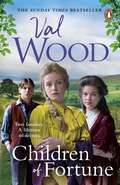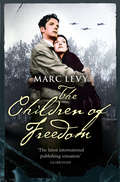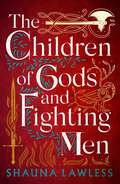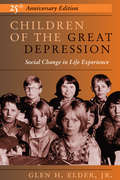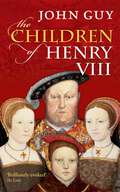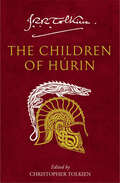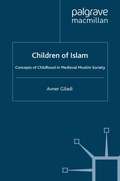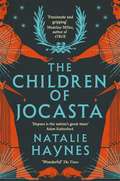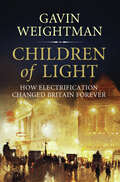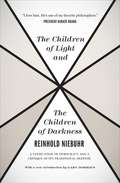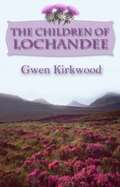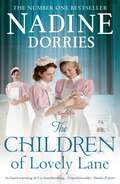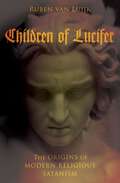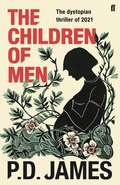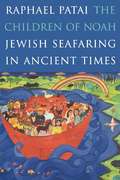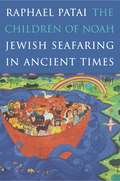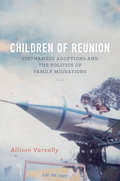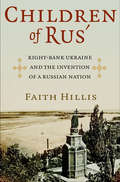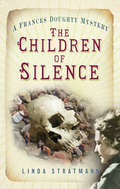- Table View
- List View
Children of Fortune: A powerful new family saga from the Sunday Times bestselling author
by Val WoodThe stunning follow-up to The Lonely Wife from bestselling author Val Wood.'With fully developed characters and a compelling story, it's no wonder the author won the Catherine Cookson Prize for Fiction for her debut... A great choice for a book club' Belfast Telegraph1864: Following the untimely death of her cold-hearted husband, Beatrix and her three children are finally free. While Ambrose has already determined his path in life, eldest son Laurie's future is less certain. With the responsibility of the family estate on his shoulders, Laurie must decide between staying in Yorkshire to farm the family land and following his dreams.Meanwhile, headstrong and independent Alicia is defying expectation and excelling at school. There she befriends the enigmatic Olivia Snowdon and they quickly become inseparable. But Olivia's past is shrouded in mystery and as the two families grow closer, secrets start to come tumbling out...A powerful story of family ties, long-held secrets and the fleeting days of childhood.Praise for Val Wood:'A heart-warming story filled with compelling action' Rosie Goodwin'Hull's answer to Catherine Cookson' BBC Radio 4's Front Row'Wonderfully fully-fleshed characters are the mainstay of [Val Wood's] stories' Peterborough Telegraph
The Children of Freedom
by Marc LevyA remarkable story of struggle and survival in World War II by France's No. 1 bestselling novelist
The Children of Gods and Fighting Men (Gael Song)
by Shauna LawlessThe first in a gripping new historical fantasy series that intertwines Irish mythology with real-life history, The Children of Gods and Fighting Men is the thrilling debut novel by Shauna Lawless. They think they've killed the last of us...981 AD. The Viking King of Dublin is dead. His young widow, Gormflaith, has ambitions for her son – and herself – but Ireland is a dangerous place and kings tend not to stay kings for long. Gormflaith also has a secret. She is one of the Fomorians, an immortal race who can do fire-magic. She has kept her powers hidden at all costs, for there are other immortals in this world – like the Tuatha Dé Danann, a race of warriors who are sworn to kill Fomorians.Fódla is one of the Tuatha Dé Danann with the gift of healing. Her kind dwell hidden in a fortress, forbidden to live amongst the mortals. Fódla agrees to help her kin by going to spy on Brian Boru, a powerful man who aims to be High King of Ireland. She finds a land on the brink of war – a war she is desperate to stop. However, preventing the loss of mortal lives is not easy with Ireland in turmoil and the Fomorians now on the rise...Reviewers on The Children of Gods and Fighting Men: 'Lawless blends fantasy with historical fiction to great effect.' SFX 'A novel that celebrates the extraordinary history and cultural traditions of Ireland while giving voice to the women who helped shape it. Highly recommended.' Lucy Holland 'An excellent read.' Mark Lawrence 'Highlander meets The Last Kingdom... I was hooked from page one.' Anthony Ryan 'Gripping and beautiful. A Celtic Last Kingdom with wild magic and fierce heroines.' Anna Smith Spark 'A beguiling blend of fantasy, history, and politics.' D.K. Fields 'A vividly written story that makes the ancient past feel contemporary.' Joseph O'Connor 'Rife with atmosphere and armies, magic and compelling characters, it swept me along and refused to be put down.' H.M. Long 'An epic historical fantasy that weaves myth and history into a sprawling tale of magic, intrigue, and war. Absorbing and richly detailed.' Ian Green 'With all the complex political machinations of A Song of Ice and Fire and the bloody battles of The Warlord Chronicles, it's ideal for fans of both.' Stephen Aryan 'An atmospheric journey into a thrilling historical fantasy world.' R.J. Barker
Children Of The Great Depression: 25th Anniversary Edition
by Glen H ElderIn this highly acclaimed work first published in 1974, Glen H. Elder Jr. presents the first longitudinal study of a Depression cohort. He follows 167 individuals born in 1920?1921 from their elementary school days in Oakland, California, through the 1960s. Using a combined historical, social, and psychological approach, Elder assesses the influence of the economic crisis on the life course of his subjects over two generations. The twenty-fifth anniversary edition of this classic study includes a new chapter on the war years entitled, ?Beyond Children of the Great Depression.?
Children Of The Great Depression: 25th Anniversary Edition (Midway Reprint Ser.)
by Glen H ElderIn this highly acclaimed work first published in 1974, Glen H. Elder Jr. presents the first longitudinal study of a Depression cohort. He follows 167 individuals born in 1920?1921 from their elementary school days in Oakland, California, through the 1960s. Using a combined historical, social, and psychological approach, Elder assesses the influence of the economic crisis on the life course of his subjects over two generations. The twenty-fifth anniversary edition of this classic study includes a new chapter on the war years entitled, ?Beyond Children of the Great Depression.?
The Children of Henry VIII
by John GuyBehind the façade of politics and pageantry at the Tudor court, there was a family drama. Nothing drove Henry VIII, England's wealthiest and most powerful king, more than producing a legitimate male heir and so perpetuating his dynasty. To that end, he married six wives, became the subject of the most notorious divorce case of the sixteenth century, and broke with the pope, all in an age of international competition and warfare, social unrest and growing religious intolerance and discord. Henry fathered four living children, each by a different mother. Their interrelationships were often scarred by jealously, mutual distrust, sibling rivalry, even hatred. Possessed of quick wits and strong wills, their characters were defined partly by the educations they received, and partly by events over which they had no control. Henry Fitzroy, Duke of Richmond, although recognized as the king's son, could never forget his illegitimacy. Edward died while still in his teens, desperately plotting to exclude his half-sisters from the throne. Mary's world was shattered by her mother's divorce and her own unhappy marriage. Elizabeth was the most successful, but also the luckiest. Even so, she lived with the knowledge that her father had ordered her mother's execution, was often in fear of her own life, and could never marry the one man she truly loved. Henry's children idolized their father, even if they differed radically over how to perpetuate his legacy. To tell their stories, John Guy returns to the archives, drawing on a vast array of contemporary records, personal letters, and first-hand accounts.
The Children of Henry VIII
by John GuyBehind the façade of politics and pageantry at the Tudor court, there was a family drama. Nothing drove Henry VIII, England's wealthiest and most powerful king, more than producing a legitimate male heir and so perpetuating his dynasty. To that end, he married six wives, became the subject of the most notorious divorce case of the sixteenth century, and broke with the pope, all in an age of international competition and warfare, social unrest and growing religious intolerance and discord. Henry fathered four living children, each by a different mother. Their interrelationships were often scarred by jealously, mutual distrust, sibling rivalry, even hatred. Possessed of quick wits and strong wills, their characters were defined partly by the educations they received, and partly by events over which they had no control. Henry Fitzroy, Duke of Richmond, although recognized as the king's son, could never forget his illegitimacy. Edward died while still in his teens, desperately plotting to exclude his half-sisters from the throne. Mary's world was shattered by her mother's divorce and her own unhappy marriage. Elizabeth was the most successful, but also the luckiest. Even so, she lived with the knowledge that her father had ordered her mother's execution, was often in fear of her own life, and could never marry the one man she truly loved. Henry's children idolized their father, even if they differed radically over how to perpetuate his legacy. To tell their stories, John Guy returns to the archives, drawing on a vast array of contemporary records, personal letters, and first-hand accounts.
The Children of Húrin
by J. R. TolkienPainstakingly restored from Tolkien’s manuscripts and presented for the first time as a fully continuous and standalone story, this illustrated paperback of the epic tale of The Children of Húrin will reunite fans of The Hobbit and The Lord of the Rings with Elves, dragons, Dwarves and Orcs, and the rich landscape and characters unique to Tolkien.
Children of Islam: Concepts of Childhood in Medieval Muslim Society (St Antony's Series)
by A. Gil'adiThis book is the result of the first comprehensive research, carried out within the framework of Islamic Studies, on childhood in medieval Muslim society. It deals with the images of children, with adults' attitudes towards them, and with concepts of childhood as reflected in legal, theological, philosophical, ethical and medical writings as well as works of belles lettres. The studies included in this volume are based on the historical-philological methodology enriched by a comparative approach towards the subject.
The Children of Jocasta
by Natalie HaynesIn The Children of Jocasta, Natalie Haynes retells the Oedipus and Antigone myths to reveal a new side of an ancient story . . .My siblings and I have grown up in a cursed house, children of cursed parents . . .Jocasta is just fifteen when she is told that she must marry the King of Thebes, an old man she has never met. Her life has never been her own, and nor will it be, unless she outlives her strange, absent husband.Ismene is the same age when she is attacked in the palace she calls home. Since the day of her parents' tragic deaths a decade earlier, she has always longed to feel safe with the family she still has. But with a single act of violence, all that is about to change.With the turn of these two events, a tragedy is set in motion. But not as you know it.
Children of Light: How Electricity Changed Britain Forever
by Gavin WeightmanIn the early 1870s a night-time view over Britain would have revealed towns lit by the warm glow of gas and oil lamps and a much darker countryside, the only light emanating from the fiery sparks of late running steam trains. However, by the end of this same decade that Victorian Britons would experience a new brilliance in their streets, town halls and other public places. Electricity had come to town. In Children of Light, Gavin Weightman brings to life not just the most celebrated electrical pioneers, such as Thomas Edison, but also the men such as Rookes Crompton who lit Henley Regatta in 1879; Sebastian Ziani de Ferranti, a direct descendant of one of the Venetian Doges, who built Britain's first major power station on the Thames at Deptford; and Anglo-Irish aristocrat, Charles Parsons inventor of the steam turbine, which revolutionised the generating of electricity.Children of Light takes in the electrification of the tramways and the London Underground, the transformation of the home with 'labour saving' devices, the vital modernising of industry during two world wars, and the battles between environmentalists and the promoters of electric power, which began in earnest when the first pylons went up. As Children of Light shows, the electric revolution has brought us luxury that would have astonished the Victorians, but at a price we are still having to pay.
The Children of Light and the Children of Darkness: A Vindication of Democracy and a Critique of Its Traditional Defense
by Reinhold NiebuhrThe Children of Light and the Children of Darkness, first published in 1944, is considered one of the most profound and relevant works by the influential theologian Reinhold Niebuhr, and certainly the fullest statement of his political philosophy. Written and first read during the prolonged, tragic world war between totalitarian and democratic forces, Niebuhr’s book took up the timely question of how democracy as a political system could best be defended. Most proponents of democracy, Niebuhr claimed, were “children of light,” who had optimistic but naïve ideas about how society could be rid of evil and governed by enlightened reason. They needed, he believed, to absorb some of the wisdom and strength of the “children of darkness,” whose ruthless cynicism and corrupt, anti-democratic politics should otherwise be repudiated. He argued for a prudent, liberal understanding of human society that took the measure of every group’s self-interest and was chastened by a realistic understanding of the limits of power. It is in the foreword to this book that he wrote, “Man’s capacity for justice makes democracy possible; but man’s inclination to injustice makes democracy necessary.” This edition includes a new introduction by the theologian and Niebuhr scholar Gary Dorrien in which he elucidates the work’s significance and places it firmly into the arc of Niebuhr’s career.
The Children of Light and the Children of Darkness: A Vindication of Democracy and a Critique of Its Traditional Defense
by Reinhold NiebuhrThe Children of Light and the Children of Darkness, first published in 1944, is considered one of the most profound and relevant works by the influential theologian Reinhold Niebuhr, and certainly the fullest statement of his political philosophy. Written and first read during the prolonged, tragic world war between totalitarian and democratic forces, Niebuhr’s book took up the timely question of how democracy as a political system could best be defended. Most proponents of democracy, Niebuhr claimed, were “children of light,” who had optimistic but naïve ideas about how society could be rid of evil and governed by enlightened reason. They needed, he believed, to absorb some of the wisdom and strength of the “children of darkness,” whose ruthless cynicism and corrupt, anti-democratic politics should otherwise be repudiated. He argued for a prudent, liberal understanding of human society that took the measure of every group’s self-interest and was chastened by a realistic understanding of the limits of power. It is in the foreword to this book that he wrote, “Man’s capacity for justice makes democracy possible; but man’s inclination to injustice makes democracy necessary.” This edition includes a new introduction by the theologian and Niebuhr scholar Gary Dorrien in which he elucidates the work’s significance and places it firmly into the arc of Niebuhr’s career.
The Children of Light and the Children of Darkness: A Vindication of Democracy and a Critique of Its Traditional Defense
by Reinhold NiebuhrThe Children of Light and the Children of Darkness, first published in 1944, is considered one of the most profound and relevant works by the influential theologian Reinhold Niebuhr, and certainly the fullest statement of his political philosophy. Written and first read during the prolonged, tragic world war between totalitarian and democratic forces, Niebuhr’s book took up the timely question of how democracy as a political system could best be defended. Most proponents of democracy, Niebuhr claimed, were “children of light,” who had optimistic but naïve ideas about how society could be rid of evil and governed by enlightened reason. They needed, he believed, to absorb some of the wisdom and strength of the “children of darkness,” whose ruthless cynicism and corrupt, anti-democratic politics should otherwise be repudiated. He argued for a prudent, liberal understanding of human society that took the measure of every group’s self-interest and was chastened by a realistic understanding of the limits of power. It is in the foreword to this book that he wrote, “Man’s capacity for justice makes democracy possible; but man’s inclination to injustice makes democracy necessary.” This edition includes a new introduction by the theologian and Niebuhr scholar Gary Dorrien in which he elucidates the work’s significance and places it firmly into the arc of Niebuhr’s career.
The Children of Light and the Children of Darkness: A Vindication of Democracy and a Critique of Its Traditional Defense
by Reinhold NiebuhrThe Children of Light and the Children of Darkness, first published in 1944, is considered one of the most profound and relevant works by the influential theologian Reinhold Niebuhr, and certainly the fullest statement of his political philosophy. Written and first read during the prolonged, tragic world war between totalitarian and democratic forces, Niebuhr’s book took up the timely question of how democracy as a political system could best be defended. Most proponents of democracy, Niebuhr claimed, were “children of light,” who had optimistic but naïve ideas about how society could be rid of evil and governed by enlightened reason. They needed, he believed, to absorb some of the wisdom and strength of the “children of darkness,” whose ruthless cynicism and corrupt, anti-democratic politics should otherwise be repudiated. He argued for a prudent, liberal understanding of human society that took the measure of every group’s self-interest and was chastened by a realistic understanding of the limits of power. It is in the foreword to this book that he wrote, “Man’s capacity for justice makes democracy possible; but man’s inclination to injustice makes democracy necessary.” This edition includes a new introduction by the theologian and Niebuhr scholar Gary Dorrien in which he elucidates the work’s significance and places it firmly into the arc of Niebuhr’s career.
The Children of Lochandee: The Lochandee Series (The Lochandee Series #1)
by Gwen KirkwoodIn 1960s Scotland, the farming industry is on the brink of huge changes, becoming more mechanised and less dependent on manpower, but at Lochandee, it is a time of hope and promise for the future.Ross and Rachel Maxwell have every reason to be proud of their expanding family. Daughter Bridie and her Nick are as happily married as they are, and working hard to build up their own farm. Eldest son Conan’s transport business is prospering, with he and Fiona planning to develop into the burgeoning tourist industry.Youngest son, Ewan, is showing the same keen interest in farming as they did at his age. But there is a cloud on the horizon – the young woman Gerda Fritz-Allan, who seems to have caught his eye. Beautiful, ambitious and utterly selfish, she has the power to wreak untold damage, changing the lives of the Maxwell family for ever.
The Children of Lovely Lane (The Lovely Lane Series #2)
by Nadine DorriesThe second gripping novel in the Lovely Lane series, from bestselling author Nadine Dorries. Perfect for fans of Dilly Court and Catherine Cookson. The nurses of Lovely Lane – Dana, Victoria, Pammy and Beth – are now in their second year and are about to face some truly harrowing and difficult times on the wards. St Angelus needs a new assistant matron, but the members of the Liverpool District Hospital Board have overruled Emily Haycock and Dr Gaskell in their choice. Enter the mysterious Miss Van Gilder from somewhere down south. The life of St Angelus is soon disrupted as her proposals turn the running of the hospital upside down and threaten the jobs of the domestics and porters. But Miss Van Gilder harbours a dark and dishonest secret, and the staff – who are used to looking after their own – set out to uncover it. Will they do so in time, before her meddling begins to affect the morale of the nurses and put the lives of their patients in danger? For one very sick little boy, especially, it will be touch and go. Can't wait for the next one? THE MOTHERS OF LOVELY LANE is out now! What people are saying about THE CHILDREN OF LOVELY LANE: 'Another fantastic book in this amazing series!' 'Nadine Dorries is fast becoming my favourite author. Once I start reading, her books are difficult to put down' 'So well written and the story line always keeps you wondering' 'There is nothing better than reading a Nadine Dorries book'
Children of Lucifer: The Origins of Modern Religious Satanism (Oxford Studies in Western Esotericism)
by Ruben van LuijkIf we are to believe sensationalist media coverage, Satanism is, at its most benign, the purview of people who dress in black, adorn themselves with skull and pentagram paraphernalia, and listen to heavy metal. At its most sinister, its adherents are worshippers of evil incarnate and engage in violent and perverse secret rituals, the details of which mainstream society imagines with a fascination verging on the obscene. Children of Lucifer debunks these facile characterizations by exploring the historical origins of modern Satanism. Ruben van Luijk traces the movement's development from a concept invented by a Christian church eager to demonize its internal and external competitors to a positive (anti-)religious identity embraced by various groups in the modern West. Van Luijk offers a comprehensive intellectual history of this long and unpredictable trajectory. This story involves Romantic poets, radical anarchists, eccentric esotericists, Decadent writers, and schismatic exorcists, among others, and culminates in the establishment of the Church of Satan by carnival entertainer Anton Szandor LaVey. Yet it is more than a collection of colorful characters and unlikely historical episodes. The emergence of new attitudes toward Satan proves to be intimately linked to the ideological struggle for emancipation that transformed the West and is epitomized by the American and French Revolutions. It is also closely connected to secularization, that other exceptional historical process which saw Western culture spontaneously renounce its traditional gods and enter into a self-imposed state of religious indecision. Children of Lucifer makes the case that the emergence of Satanism presents a shadow history of the evolution of modern civilization as we know it. Offering the most comprehensive account of this history yet written, van Luijk proves that, in the case of Satanism, the facts are much more interesting than the fiction.
Children of Lucifer: The Origins of Modern Religious Satanism (Oxford Studies in Western Esotericism)
by Ruben van LuijkIf we are to believe sensationalist media coverage, Satanism is, at its most benign, the purview of people who dress in black, adorn themselves with skull and pentagram paraphernalia, and listen to heavy metal. At its most sinister, its adherents are worshippers of evil incarnate and engage in violent and perverse secret rituals, the details of which mainstream society imagines with a fascination verging on the obscene. Children of Lucifer debunks these facile characterizations by exploring the historical origins of modern Satanism. Ruben van Luijk traces the movement's development from a concept invented by a Christian church eager to demonize its internal and external competitors to a positive (anti-)religious identity embraced by various groups in the modern West. Van Luijk offers a comprehensive intellectual history of this long and unpredictable trajectory. This story involves Romantic poets, radical anarchists, eccentric esotericists, Decadent writers, and schismatic exorcists, among others, and culminates in the establishment of the Church of Satan by carnival entertainer Anton Szandor LaVey. Yet it is more than a collection of colorful characters and unlikely historical episodes. The emergence of new attitudes toward Satan proves to be intimately linked to the ideological struggle for emancipation that transformed the West and is epitomized by the American and French Revolutions. It is also closely connected to secularization, that other exceptional historical process which saw Western culture spontaneously renounce its traditional gods and enter into a self-imposed state of religious indecision. Children of Lucifer makes the case that the emergence of Satanism presents a shadow history of the evolution of modern civilization as we know it. Offering the most comprehensive account of this history yet written, van Luijk proves that, in the case of Satanism, the facts are much more interesting than the fiction.
The Children of Men
by P. D. JamesAward-winning P.D. James, one of the masters of British crime fiction, plots this atmospheric and disturbing novel in the year 2021. Children of Men is a brilliant mystery possessing all of the qualities which distinguish P.D. James as a novelist. Under the despotic rule of Xan Lyppiatt, the Warden of England, the old are despairing and the young cruel. Theo Faren, a cousin of the Warden, lives a solitary life in this ominous atmosphere. That is, until a chance encounter with a young woman leads him into contact with a group of dissenters. Suddenly his life is changed irrevocably, as he faces agonising choices which could affect the future of mankind. PD James is the world's pre-eminent crime writer, most famous for her Adam Dalgliesh mysteries and for her bestselling titles Death Comes to Pemberley and The Murder Room. Children of Men was adapted into a hit film in 2006, directed by Alfonso Cuarón the film starred Clive Owen, Michael Caine and Julianne Moore.
The Children of Noah: Jewish Seafaring in Ancient Times
by Raphael PataiHere the late Raphael Patai (1910-1996) recreates the fascinating world of Jewish seafaring from Noah's voyage through the Diaspora of late antiquity. In a work of pioneering scholarship, Patai weaves together Biblical stories, Talmudic lore, and Midrash literature to bring alive the world of these ancient mariners. As he did in his highly acclaimed book The Jewish Alchemists, Patai explores a subject that has never before been investigated by scholars. Based on nearly sixty years of research, beginning with study he undertook for his doctoral dissertation, The Children of Noah is literally Patai's first book and his last. It is a work of unsurpassed scholarship, but it is accessible to general readers as well as scholars. An abundance of evidence demonstrates the importance of the sea in the lives of Jews throughout early recorded history. Jews built ships, sailed them, fought wars in them, battled storms in them, and lost their lives to the sea. Patai begins with the story of the deluge that is found in Genesis and profiles Noah, the father of all shipbuilders and seafarers. The sea, according to Patai's interpretation, can be seen as an image of the manifestation of God's power, and he reflects on its role in legends and tales of early times. The practical importance of the sea also led to the development of practical institutions, and Patai shows how Jewish seafaring had its own culture and how it influenced the cultures of Mediterranean life as well. Of course, Jewish sailors were subject to the same rabbinical laws as Jews who never set sail, and Patai describes how they went to extreme lengths to remain in adherence, even getting special emendations of laws to allow them to tie knots and adjust rigging on the Sabbath. The Children of Noah is a capstone to an extraordinary career. Patai was both a careful scholar and a gifted storyteller, and this work is at once a vivid history of a neglected aspect of Jewish culture and a treasure trove of sources for further study. It is a stimulating and delightful book.
The Children of Noah: Jewish Seafaring in Ancient Times
by Raphael PataiHere the late Raphael Patai (1910-1996) recreates the fascinating world of Jewish seafaring from Noah's voyage through the Diaspora of late antiquity. In a work of pioneering scholarship, Patai weaves together Biblical stories, Talmudic lore, and Midrash literature to bring alive the world of these ancient mariners. As he did in his highly acclaimed book The Jewish Alchemists, Patai explores a subject that has never before been investigated by scholars. Based on nearly sixty years of research, beginning with study he undertook for his doctoral dissertation, The Children of Noah is literally Patai's first book and his last. It is a work of unsurpassed scholarship, but it is accessible to general readers as well as scholars. An abundance of evidence demonstrates the importance of the sea in the lives of Jews throughout early recorded history. Jews built ships, sailed them, fought wars in them, battled storms in them, and lost their lives to the sea. Patai begins with the story of the deluge that is found in Genesis and profiles Noah, the father of all shipbuilders and seafarers. The sea, according to Patai's interpretation, can be seen as an image of the manifestation of God's power, and he reflects on its role in legends and tales of early times. The practical importance of the sea also led to the development of practical institutions, and Patai shows how Jewish seafaring had its own culture and how it influenced the cultures of Mediterranean life as well. Of course, Jewish sailors were subject to the same rabbinical laws as Jews who never set sail, and Patai describes how they went to extreme lengths to remain in adherence, even getting special emendations of laws to allow them to tie knots and adjust rigging on the Sabbath. The Children of Noah is a capstone to an extraordinary career. Patai was both a careful scholar and a gifted storyteller, and this work is at once a vivid history of a neglected aspect of Jewish culture and a treasure trove of sources for further study. It is a stimulating and delightful book.
Children of Reunion: Vietnamese Adoptions and the Politics of Family Migrations
by Allison VarzallyIn 1961, the U.S. government established the first formalized provisions for intercountry adoption just as it was expanding America's involvement with Vietnam. Adoption became an increasingly important portal of entry into American society for Vietnamese and Amerasian children, raising questions about the United States' obligations to refugees and the nature of the family during an era of heightened anxiety about U.S. global interventions. Whether adopting or favoring the migration of multiracial individuals, Americans believed their norms and material comforts would salve the wounds of a divisive war. However, Vietnamese migrants challenged these efforts of reconciliation. As Allison Varzally details in this book, a desire to redeem defeat in Vietnam, faith in the nuclear family, and commitment to capitalism guided American efforts on behalf of Vietnamese youths. By tracing the stories of Vietnamese migrants, however, Varzally reveals that while many had accepted separations as a painful strategy for survival in the midst of war, most sought, and some eventually found, reunion with their kin. This book makes clear the role of adult adoptees in Vietnamese and American debates about the forms, privileges, and duties of families, and places Vietnamese children at the center of American and Vietnamese efforts to assign responsibility and find peace in the aftermath of conflict.
Children of Rus': Right-Bank Ukraine and the Invention of a Russian Nation
by Faith HillisIn Children of Rus’, Faith Hillis recovers an all but forgotten chapter in the history of the tsarist empire and its southwestern borderlands. The right bank, or west side, of the Dnieper River—which today is located at the heart of the independent state of Ukraine—was one of the Russian empire’s last territorial acquisitions, annexed only in the late eighteenth century. Yet over the course of the long nineteenth century, this newly acquired region nearly a thousand miles from Moscow and St. Petersburg generated a powerful Russian nationalist movement. Claiming to restore the ancient customs of the East Slavs, the southwest’s Russian nationalists sought to empower the ordinary Orthodox residents of the borderlands and to diminish the influence of their non-Orthodox minorities. Right-bank Ukraine would seem unlikely terrain to nourish a Russian nationalist imagination. It was among the empire’s most diverse corners, with few of its residents speaking Russian as their native language or identifying with the culture of the Great Russian interior. Nevertheless, as Hillis shows, by the late nineteenth century, Russian nationalists had established a strong foothold in the southwest’s culture and educated society; in the first decade of the twentieth, they secured a leading role in local mass politics. By 1910, with help from sympathetic officials in St. Petersburg, right-bank activists expanded their sights beyond the borderlands, hoping to spread their nationalizing agenda across the empire.Exploring why and how the empire’s southwestern borderlands produced its most organized and politically successful Russian nationalist movement, Hillis puts forth a bold new interpretation of state-society relations under tsarism as she reconstructs the role that a peripheral region played in attempting to define the essential characteristics of the Russian people and their state.
The Children of Silence: A Frances Doughty Mystery 5 (A\frances Doughty Mystery Ser. #5)
by Linda StratmannLONDON, 1881: When a body is found in the Paddington canal basin, a woman with a hearing impairment claims that the remains are those of her missing husband, who disappeared three years ago. Unable to prove her case, she appeals to Frances Doughty, the lady detective, to investigate. In this, her fifth case, Frances soon learns that the missing man has secrets of his own, and, when another body is discovered and a witness is viciously attacked, it becomes clear that she must choose her allies wisely. The fifth book in the popular Frances Doughty Mystery series.
